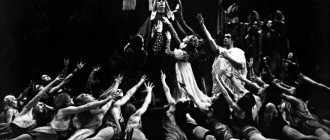Summary of the music lesson “Musical image and skill of the performer” (6th grade)
Lesson No. 6 (6th grade)
Topic: Musical image and performer's skill.
“These are not theatrical masks, but human ones resurrected at every performance”
Goal: To introduce students to the outstanding singer F. Chaliapin
Objectives: using the example of a performer’s creativity, generalize the concept of a performer’s skill, consolidate knowledge about singing voices, genres of vocal music; develop the ability to think about music, about the features of its implementation, give a generalized description of performing skills, improve vocal skills; cultivate patriotism and interest in Russian performing arts
Lesson type: Combined lesson
View: lesson - portrait
Listening material
M.I.Glinka “Rondo of Farlafa” from the opera “Ruslan and Lyudmila” performed by F. Chaliapin M.I.Glinka “Susanina’s Aria” from the opera “Ivan Susanin”.
N.A. Rimsky-Korsakov “Song of the Varangian Guest” from the opera “Sadko” performed by F. Chaliapin
During the classes
I. Organizational moment(
musical greeting)
II. Vocal works
and “Swallow” by E. Krylov, performance of a familiar song, work on the expressiveness of performance, ensemble
1. Chanting on the first 2 reference sounds (sext)
2. Singing in phrases - monitor the purity of intonation and correct breathing
3. Conversation
according to the content of the song:
—What does the song tell about? (the image of a swallow is revealed, which always strives to return to its homeland)
— With what feeling should you perform it? Determining the performance plan of the song, climax (verse 3)
Expressive class performance of a song
III. Work on the topic:
— What genre was covered in the lesson?
— A song is a genre of vocal music.
— What kind of music do we call vocal?
- Music intended for voice.
Now we will hear a familiar piece, try to remember its name, the author of the music, and determine the type of voice of the performer.
Listening to “Susanin’s aria” (fragment)
— A fragment from Ivan Susanin’s aria from the opera of the same name was heard. This aria was performed by a low male voice, such a voice is called a bass. The first performer of Susanin's part was bass O. Petrov (slide No. 2)
- Let's remember the classification of voices (working with slide No. 3) students name male and female voices, distribute them by height)
— Today we will talk about the famous singer F. Shalapin.
“Brainstorm” - What do I know about Chaliapin?
Addition - student's message about the voice of a great singer
The famous music critic Yu. Engel wrote in 1889 about Chaliapin’s voice (from the collection “Chaliapin”, vol. 2, M. 1958):
“The singer’s voice is one of the most beautiful in timbre that we have ever heard. He is strong and even, although by his very nature (bass-baritone, high bass) he sounds on very low notes less full, stable and strong than on the upper ones... at the top he is capable of a powerful rise, of rare brilliance and scope... But What represents the most characteristic feature of this voice, what elevates it above dozens of other similar or even better voices in terms of material, is its ... internal flexibility and penetration.”
Summary of what has been said
Working in a notebook
: Construction of a logical chain: “F. Chaliapin - Russian performer (bass) - unique voice timbre - ......
Portrait display (
Kustodiev) Slide No. 4
Slide number 5
Listening to "Rondo"
Farlafa" performed by F. Chaliapin
— Determine the characteristic features of the voice you heard? (power, strength, velvety)
The divine beauty of Chaliapin's voice captivated listeners from all countries. His high bass, delivered naturally, with a velvety, soft timbre, sounded full-blooded, powerful and possessed a rich palette of vocal intonations.
— What feeling does each performance evoke in the listener? (Showing an illustration of Chaliapin in character) Slide No. 6
— Is it possible to talk about the truth of feeling in this performance?
— How do you understand Chaliapin’s words: “Only the truthful is beautiful,” “There are no two truths of feeling.” Therefore, I recognized for myself that the only correct path to beauty is the truth.”
Reading passage
from Chaliapin's memoirs (textbook p. 26)
— What is needed to achieve a truthful performance?
— You need to feel what you are singing about
“Song of the Varangian Guest” hearing
, analysis
— How do you imagine the image of this hero? Show illustration (Slide No.)
— What intonations do we hear in music: majesty, regularity, confidence, beauty?
IV. Result:
analysis of the epigraph “These are not theatrical masks, but human lives resurrected at every performance.”
— How do you understand Chaliapin’s words? (quote)
— What images created by the great singer have we met today?
- What kind of voice did he have?
Students complete the logical chain “- great artist”
Expressive performance of the song “You are a man” by E. Krylatov
Used materials:
Textbook "Music". 6th grade. Kritskaya E. D., Sergeeva G. P. - M.: Education, 2007.
https://www.shalyapin-museum.org/content/view/5/479/


